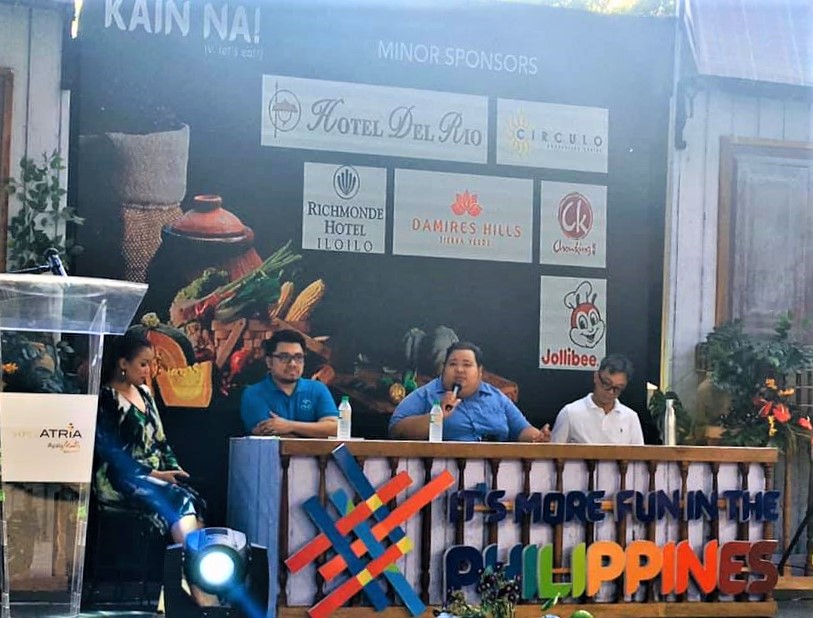I was invited to discuss food blogging and the Ilonggo food and culture together with fellow Iloilo Bloggers Society member Antoine Greg Flores and J. Scott G. Saria during the 3-day Kain Na!
Scott is a well-known name in the Iloilo hotel industry before the exponential rise to popularity of the Facebook group Kaon Ta, Iloilo (KTI) while Greg is recognized among pioneer bloggers in the Iloilo online community. Me? I’m an incidental food blogger. I’m an opinion writer before I ventured into blogging.
Kain Na! Experience Western Visayas First was a Food and Travel Festival organized by the Dept. of Tourism Region VI in partnership with the Dept. of Agriculture and the Ayala Malls as such it was held at the Atria Park District.
See: https://peoplesdomain.net/ilonggo-foodgasm-in-kain-na-3-day-food-and-travel-fest/
Our participation in the program was facilitated by a common friend Mae Tamayo-Panes, who is a tourism development advocate and a managing consultant of the Perfect Planners, among the many roles that this hyper-active woman plays in Iloilo.

Food and eating is an interesting topic among Ilonggos and the social media account of Ilonggo netizens are rich with photos and narratives about food and dining experience. There are numerous Facebook pages and groups on food, but Kaon Ta, Iloilo! (KTI!) is perhaps the “go to” site considering that it now has more than 100k member-followers.
I also take KTI! as an example on the topic of food blogging for numerous reasons. The site has allowed me to have the following: gather observations about Ilonggos’ food blogging practices; get oriented regarding online attitude (profile) of Ilonggos on food; and, acquire a sense of the Ilonggo food culture through their food choices. Let me share some of the points that I brought into the panel discussion.
First, food blogging is everybody’s business. Food blogging is not an exclusive or a guarded business of bloggers alone. Everybody who brought in a recipe and who discusses food processing, cooking methods, and food presentation are bloggers. This is how the internet has democratized so many things – everybody is a content creator.
Iloilo has an abundant pull of “citizens food bloggers”. Everyday postings by Ilonggos continue to enrich, if not redefine, Iloilo’s culinary landscape through experimentation of modern prep techniques and by describing enduring traditional home-cooked recipes into the online chatter. Considering that food is integral in everyday life, food blogging has become a natural practice among Ilonggos.
Second, an honest to goodness food is a hit among Ilonggos. Ilonggos are adventurous on food because they are among the most well-traveled people. Remember that Iloilo’s major economic driver is OFW remittances – this a money that energizes vanity services, novelty and luxurious items, travel and recreation, and – food and festivity. The Ilonggos travel to many different places, not only to enjoy comfort and convenience, but quality food.
But at the end of the day, Ilonggos love a straightforward cooking. This is the reason why they prefer a fresh fish grilled with only a rock salt as a marinade. They frown upon a fresh dish subjected to a cocktail of condiments. Too many mixtures means it is not fresh and it violates the Ilonggos’ fixation on fresh ingredients. Fresh and simple cooking is tasty; hence, a pleasurable experience for an Ilonggo.
Third, social media is good but Ilonggos rely on word-of-mouth. The Ilonggos gets attracted to different types of food when posted on social media. Food is an inevitable magnet and they will drive a car to wherever that food is located, and no matter how big a joint or how small a carinderia it is. However, they will ask a friend or two about the place and the food. Ilonggos are highly dependent on a word of mouth and this is the reason why they shoutout over social media for recommendations on where to eat, what food to order, and how much it costs.
Food makes the Ilonggos happy, but one must be aware that the Ilonggos are among the most demanding clients when it comes to food, because a typical Ilonggo family knows how to cook – they know one or two secret ingredient or a technique that can level-up a simple dish. A single disappointing experience will not make them come back to a place and a word of mouth has its way of going viral.
In addition, an Ilonggo will try and spend for food despite it’s pricey as long as it is of good quality – it is quality that makes the Ilonggos cost-conscious. They know what is value for money.
I cannot be certain how the digital era has affected the eating habits of the Ilonggos. One thing I’m sure of, social media has accelerated the level of interest among Ilonggos on food and the intensity of engagement may have perhaps manifested in weight gain.